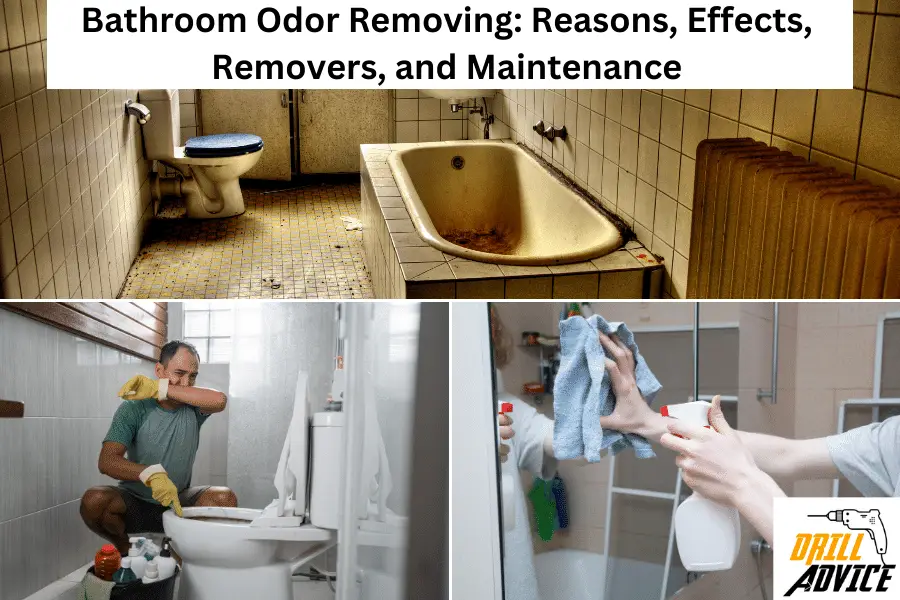
The bathroom is an important hygienic area. A bathroom can spread a bad smell due to its improper cleaning and maintenance. Bathroom odor can be controlled and removed successfully by following proper methods and maintenance.
Bathroom odor occurs due to insufficient ventilation, accumulation of organic matter, mold and mildew, toilet issues, and use of improper cleaning agents. Bathroom odor causes sever health impacts such as bacteria infection, chemical exposure (ammonia due to urine), and respiratory problems. Using natural cleaners and commercial products, bathroom odor can be removed successfully.
You can use vinegar, baking soda, lemon, tea tree, odor-removing sprays, toilet tablets, enzyme cleaners, and air purifiers to remove bathroom odor effectively. By following the below steps, these removers can be used effectively.
You should not use bleach with ammonia, vinegar on stone (non-polished), boiling water on PVC, and mixing multiple cleaners together to clan and remove the bathroom odor. Because these can produce toxic fumes, decay, heat the drains, and lose the drain connections easily.
You should maintain the bathroom by improving the ventilation, regular cleaning, using drain covers, inspecting leaks, and using odor absorbers properly in order to reduce the bathroom odor.
What are the Reasons for Bathroom Odors?
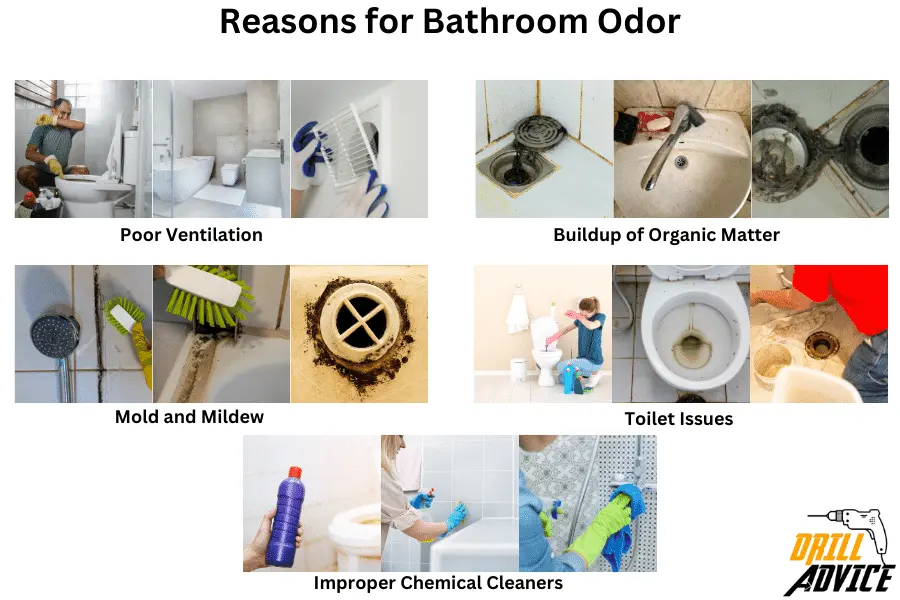
Bathroom odor occurs due to these 5 main reasons. Those are poor ventilation, buildup of organic matter, mold and mildew, toilet issues, and using improper chemical cleaners.
- Poor Ventilation – Poor ventilation can improve the odor in the bathroom. Because lack of proper ventilation traps moisture and odors in the bathroom.
- Buildup of Organic Matter – The most common organic matter in the bathroom, such as soap residues, hair, and skin cells, can accumulate in drains. When this organic matter buildup decomposes over time, it releases unpleasant smells.
- Mold and Mildew – Mold and mildew organisms can produce a musty, earthy smell in the higher moisture level in the bathroom.
- Toilet Issues – A poorly sealed toilet can release sewer gases back into your bathroom. If you’re smelling something akin to rotten eggs, check your toilet seal.
- Improper Chemical Cleaners – Overuse or mixing different types of chemical cleaners for bathroom cleaning can produce smells as harsh as the odors you’re trying to eliminate.
What are the Health Impacts of Bathroom Odor?
The severe health impacts of bathroom odor are bacterial infection, respiratory problems, chemical exposure, and increasing mental health. The health impact affects the user’s health negatively.
- Bacteria Infections – Harmful bacteria and microorganisms can be infected through the skin when you open a ventilated bathroom.
- Respiratory Problems – Mold and mildew in the bathroom can cause or exacerbate respiratory issues like asthma and allergies.
- Chemical Exposure – Strong chemical smells (Ammonia due to Urine) can irritate the eyes and throat, leading to potential health risks if the exposure is consistent over time.
- Increase Mental Stress – Constant exposure to bad odors can affect your mental effect. It causes stress and anxiety.
What are the Bad Effects of Bathroom Odor?
These are the 2 main bad effects of the bathroom odor. These bad effects cause to a bad user experience.
- Unpleasant Experience – A bad-smelling bathroom is uncomfortable for everyone. When it is used daily it can be a bad experience.
- Reduced Indoor Air Quality – Lingering bathroom odors can impact the air quality within your home. Poor air quality can lead to respiratory issues, allergies, and other health problems, especially if you or your family members have pre-existing conditions.
What Can You Use to Remove Bathroom Odor?
You can use both natural cleaners and commercial cleaners to remove the bathroom odor. Vinegar, baking soda, lemon juice, and tea tree oil are the natural bathroom odor removers. As commercial bathroom odor removers, you can use disinfectant sprayers, enzymic cleaners, air purifiers, air fresheners toilet tables,
Natural Compounds for Bathroom Odor
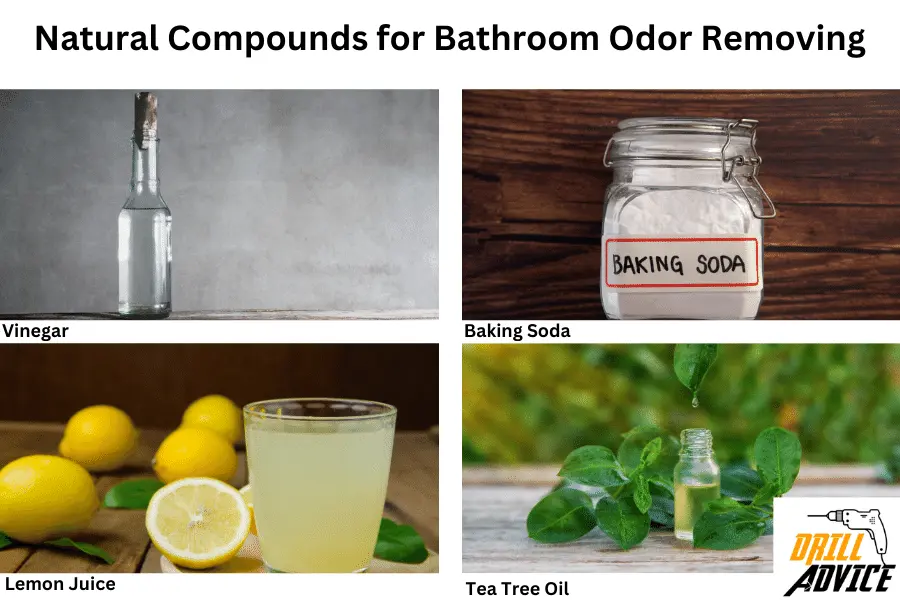
- Vinegar – Vinegar is a wide range used natural cleaners that can help eliminate odors in the bathroom. Vinegar can be used by spraying on the surface of bathroom fixtures and removing it.
- Baking Soda – Baking soda has odor-absorbing properties. You can use baking soda by sprinkling on the bathroom fixtures.
- Lemon Juice – The acidity in lemon juice can help neutralize odors. Lemon juice not only removes odors but also leaves a fresh citrus scent behind.
- Tea Tree Oil – Tea tree oil can be sprayed on the bathroom floor and fixtures in order to remove the odors and kill the bacteria successfully.
Commercial Products for Bathroom Odor
- Disinfectant Sprays: Many commercial disinfectant sprays are designed to eliminate bathroom odors.
- Enzymatic Cleaners: Enzymatic cleaners are effective in breaking down organic matter that causes odors. They work by targeting the source of the odor and breaking it down at a molecular level.
- Air Fresheners: Air fresheners can mask bathroom odors temporarily.
- Air Purifiers – Air purifiers can offer a more advanced solution for removing airborne particles that contribute to bad odours.
How to Remove Bathroom Odor?
Bathroom odors can be removed using vinegar, baking soda, lemon, tea tree, odor-removing spray, toilet cleaning tables, enzyme cleaners, and air purifiers. Below are the steps and ways to use these cleaners in an effective way.
Read More About
- Bathroom Sink Cleaning: Reasons, Equipment, Steps and Maintenence
- Bathroom Toilet Cleaning: Reasons, Equipment, Steps and Maintenance
- Bathroom Floor Cleaning: Reasons, Effects, Cleaners, Steps, and Maintenance
- Bathtub Cleaning: Reasons, Equipment, Steps and Maintenance
- Bathroom Faucet Cleaning: Reasons, Equipment, Steps and Maintenance
1. Using Vinegar and Baking Soda

- Mix the Ingredients: Combine half a cup of vinegar with a quarter cup of baking soda in a bowl.
- Apply: Pour the mixture down the drain.
- Wait: Let it sit for at least 30 minutes to break down grime and kill bacteria.
- Flush: Run hot water to flush away the residue.
2. Using Lemon and Water

- Prepare Lemon Water: Mix equal parts of lemon juice and water in a spray bottle.
- Spray: Generously spray the lemon water on surfaces like tiles, sinks, and even the toilet.
- Wipe: After letting it sit for a few minutes, wipe it off with a clean cloth.
3. Using Tea Tree Oil

- Create the Solution: Add a few drops of tea tree oil to a spray bottle filled with water.
- Spray: Spray on the target areas prone to mold and mildew.
- Let it Sit: Wait for at least 30 minutes for the oil to do its magic.
- Wipe Away: Use a damp cloth to wipe the area clean.
4. Using Odor-Removing Sprays
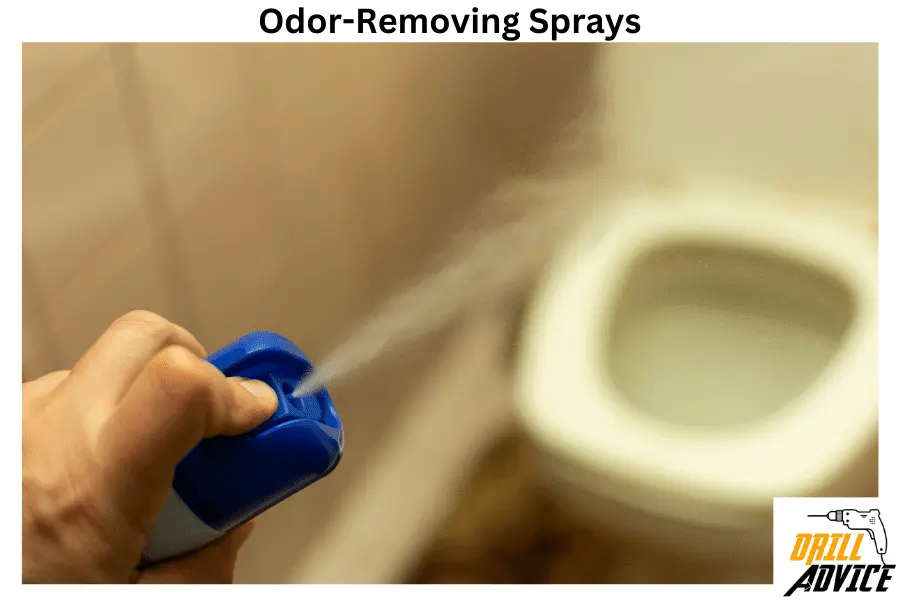
- Shake Well: Ensure the product is well-mixed.
- Spray: Liberally spray the air and surfaces.
- Let it Sit: Give it a moment to neutralize the odor before entering the bathroom.
5. Using Toilet Cleaning Tablets
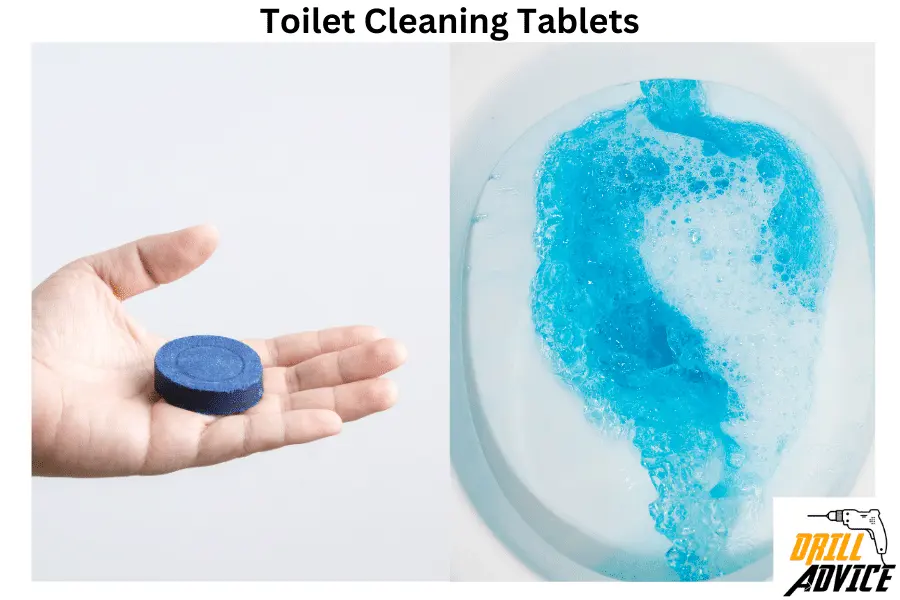
- Read Instructions: Always read the manufacturer’s guidelines for the toilet cleaning tablets.
- Drop: Place a toilet cleaning tablet in the toilet.
- Flush: Flush to disperse the cleaner throughout the toilet.
- Replace: Swap out the tablet as recommended by the manufacturer.
6. Using Enzyme Cleaners
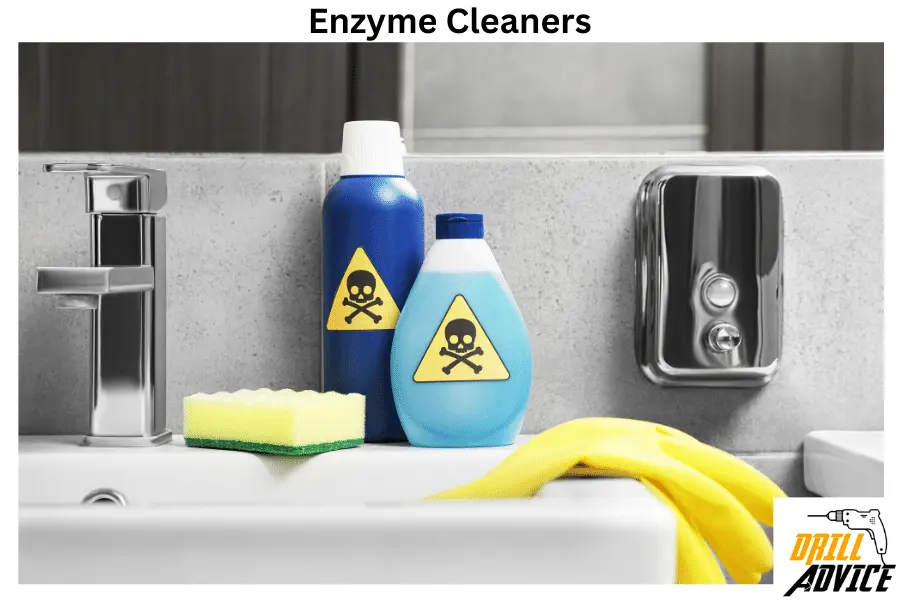
- Pour: Follow the instructions on the label, and pour the cleaner into the affected drain.
- Wait: Let it sit to break down organic matter, usually for 30 minutes to an hour.
- Rinse: Flush the drain with hot water.
7. Using Air Purifiers
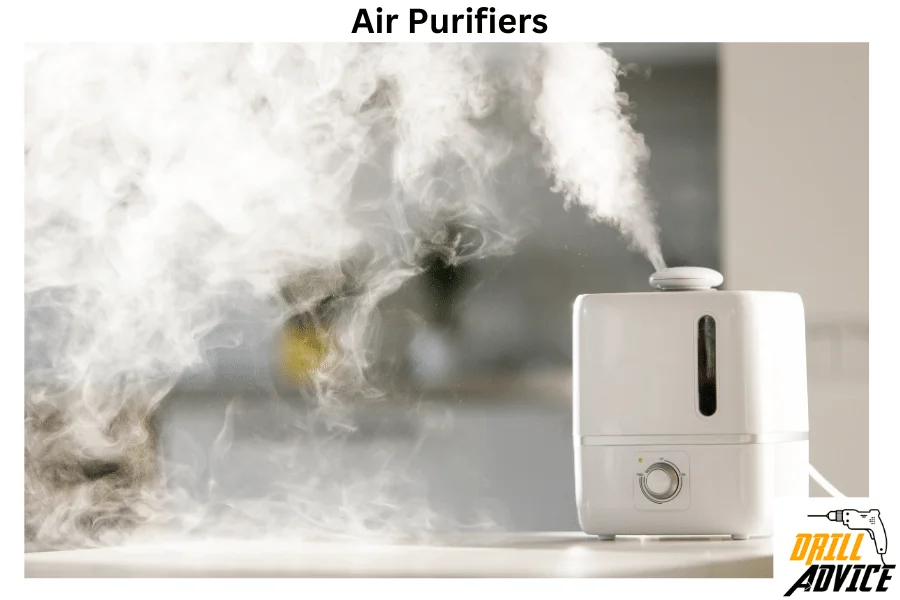
- Position: Place the air purifier in a suitable location in the bathroom.
- Turn On: Plug it in and turn it on according to the manufacturer’s instructions.
- Run: Let it run continuously or as needed to improve air quality.
What Should You Not Use to Remove Bathroom Odor?
You should not use bleach with ammonia, vinegar on stone (not sealed), boiled water on PVC, and mix many cleaning agents together. These will cause damage to the bathroom floor and drains and produce toxic fumes to the user.
- Do not mix Bleach and Ammonia – Do not mix bleach and ammonia together. When you mix them, they produce toxic fumes. Hence you ahoud not these two together while you are cleaning the bathroom to remove odor.
- Vinegar on Stone Surfaces – Vinegar is acidic, and it can decay the stone countertops or tiles. Hence, when you use vinegar, make sure to use it with water and quickly wipe it out. Do not keep the vinegar on the stone surface too long. Instead of this, you can use mild pH cleaners..
- Boiling Water in Plastic Drains – You should not pour the boiling water into the bathroom drains when you clean the bathroom drain to prevent odor. This will damage the PVC and other rubber and plastic components in the drain system.
- Using Too Many Products Together – Avoid using multiple cleaning agents at the same time as they can react with each other. This can create harmful fumes.
How to Maintain a Bathroom Without Odor?
A bathroom can be maintained without odor by following these 4 main steps. Those are improving proper ventilation, regular cleaning, using drain covers, inspecting leaking, and using the odor absorbers in the bathroom.
- Improve ventilation using an exhaust fan – Switch on the exhaust fan during and after showers. Leave it on for at least 15-20 minutes post-shower to remove excess moisture.
- Regular Cleaning – Clean your bathroom at least once a week. Pay special attention to the toilet, drains, and any spots prone to mold.
- Use a Drain Cover – Use a simple drain cover to prevent the hair and other organic matter from going down the drain, reducing the chance of smells developing.
- Inspect Leaks – Regularly inspect your bathroom for any water leaks, especially around the toilet and sink.
- Use Odor Absorbers – Place natural odor absorbers like activated charcoal or baking soda in strategic corners. Replace them monthly.
